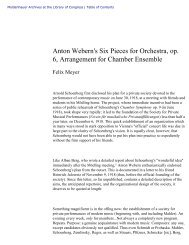Country Profile: Cuba - American Memory - Library of Congress
Country Profile: Cuba - American Memory - Library of Congress
Country Profile: Cuba - American Memory - Library of Congress
You also want an ePaper? Increase the reach of your titles
YUMPU automatically turns print PDFs into web optimized ePapers that Google loves.
<strong>Library</strong> <strong>of</strong> <strong>Congress</strong> – Federal Research Division <strong>Country</strong> <strong>Pr<strong>of</strong>ile</strong>: <strong>Cuba</strong>, September 2006<br />
Foreign Aid: During the 1960–90 period, socialist countries provided nearly all <strong>of</strong> the<br />
substantial development financing received by <strong>Cuba</strong>. Originating primarily from the former<br />
Soviet Union and amounting to more than US$65 billion, the aid covered a wide range <strong>of</strong><br />
economic activities, mostly taking the form <strong>of</strong> loans repayable at very low interest rates.<br />
Approximately 40 percent <strong>of</strong> the flow <strong>of</strong> resources (about US$25.7 billion) took the form <strong>of</strong><br />
repayable loans (development credits, 13 percent; and credits to finance trade deficits, 27<br />
percent); nonrepayable price subsidies accounted for the remaining 60 percent (US$39.4 billion).<br />
<strong>Cuba</strong> receives little multilateral agency development assistance because it is barred from<br />
membership in the World Bank, the International Monetary Fund, and the Inter-<strong>American</strong><br />
Development Bank. Its main sources <strong>of</strong> multilateral assistance are European Union emergency<br />
relief and United Nations agencies, such as the World Food Programme, the United Nations<br />
Development Programme, the United Nations Regular Programme <strong>of</strong> Technical Assistance, and<br />
the United Nations Children’s Fund. The Organization <strong>of</strong> the Petroleum Exporting Countries has<br />
c<strong>of</strong>inanced a development loan for the energy sector. In recent years, Latin <strong>American</strong> countries<br />
such as Venezuela also have provided some aid. Total multilateral aid amounted to only about<br />
US$20 million in 2004, whereas bilateral aid totaled US$69 million that year.<br />
Currency and Exchange Rate: <strong>Cuba</strong>n currency has no <strong>of</strong>ficial value outside the country. <strong>Cuba</strong><br />
has two domestic <strong>of</strong>ficial currencies in circulation: the <strong>Cuba</strong>n peso (CuP) and the convertible<br />
peso (CUC), both <strong>of</strong> which are equivalent to 100 centavos. As <strong>of</strong> November 8, 2004, <strong>Cuba</strong>n<br />
authorities eliminated the circulation <strong>of</strong> U.S. dollars and any other “convertible currency” in the<br />
country, at least <strong>of</strong>ficially. Tourists and foreign business visitors are required to exchange their<br />
currency into convertible pesos on arrival because the <strong>Cuba</strong>n government now requires the use <strong>of</strong><br />
convertible pesos for all transactions other than the most basic street-vendor-type purchases, for<br />
which the <strong>Cuba</strong>n peso is used. Retail stores that had been selling goods in U.S. dollars now can<br />
accept only convertible pesos, which are considered the equivalent <strong>of</strong> tourist dollars. The<br />
convertible peso is used for luxury products available in tourist boutiques known as “dollar<br />
shops” or for tourist-related services. In addition, <strong>Cuba</strong>ns must use convertible pesos to pay rents<br />
or make major purchases, even though most workers are paid in <strong>Cuba</strong>n pesos rather than<br />
convertible pesos. As <strong>of</strong> September 27, 2006, the exchange rates for the two <strong>Cuba</strong>n currencies<br />
were: US$1=22.22 <strong>Cuba</strong>n pesos (floating domestic rate); and US$1=CUC0.93 (a fixed rate). The<br />
exchange <strong>of</strong> U.S. dollars for convertible pesos also bears a 10 percent tax that is not applied to<br />
other foreign currencies.<br />
Fiscal Year: <strong>Cuba</strong>’s fiscal year coincides with the calendar year.<br />
TRANSPORTATION AND TELECOMMUNICATIONS<br />
Overview: <strong>Cuba</strong>’s transportation infrastructure consists <strong>of</strong> an integrated network <strong>of</strong> roads,<br />
railroads, airfields, ports, and inland waterways. <strong>Cuba</strong> has good transportation facilities and<br />
networks in the western and central portions <strong>of</strong> the island; the eastern portion <strong>of</strong> the island is less<br />
developed. Roads, railroads, and air and maritime transportation services provide access to<br />
almost every location on the island. The infrastructure <strong>of</strong> ports, airports, and warehouses<br />
supports extensive foreign trade. Land transportation has been severely affected by the economic<br />
crisis. Lack <strong>of</strong> spare parts for the bus and truck fleet has reduced significantly the number <strong>of</strong><br />
19



![Albert Einstein Papers [finding aid]. Library of Congress. [PDF ...](https://img.yumpu.com/21604228/1/190x245/albert-einstein-papers-finding-aid-library-of-congress-pdf-.jpg?quality=85)





![American Colony in Jerusalem Collection [finding aid]. Library of ...](https://img.yumpu.com/17941275/1/190x245/american-colony-in-jerusalem-collection-finding-aid-library-of-.jpg?quality=85)



![Piccard Family Papers [finding aid]. - American Memory - Library of ...](https://img.yumpu.com/17941234/1/190x245/piccard-family-papers-finding-aid-american-memory-library-of-.jpg?quality=85)


